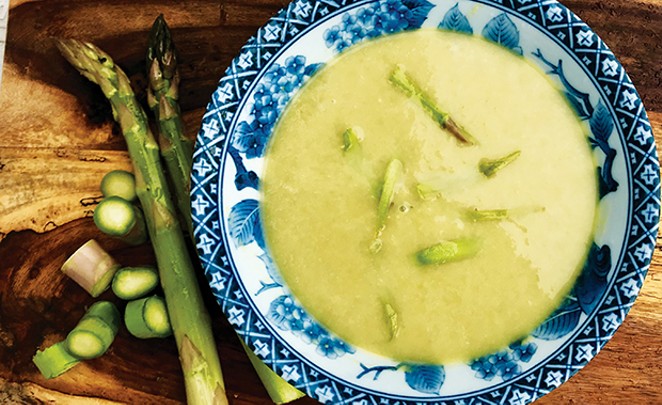I dearly love asparagus – but I only allow myself to enjoy it in the spring and early summer, when local asparagus becomes available. After a winter of trying to come up with interesting and varied ways to prepare cabbages and root vegetables, those first fresh green shoots are the official prelude to the new season of homegrown vegetables. Asparagus is one of those vegetables where the in-season local variety tastes far superior to imported off-season asparagus. Just-harvested asparagus has a high sugar content but the sugar quickly turns to starch as it sits and becomes bland and starchy.
Fresh asparagus spears will have firm stems and tight tips, similar to an unopened rosebud. If the stems are wrinkled or the tops are frayed and feathery, the asparagus is not very fresh. To preserve freshness, asparagus should be placed in one inch of water in a wide-mouth container, stem side down, covered with a plastic bag and stored in the refrigerator.
World-renowned chef Thomas Keller (chef/owner of Napa’s French Laundry and New York’s Per Se) recommends dry-roasting or grilling asparagus. “Because the chemical that makes asparagus taste like asparagus is water-soluble, we gravitate towards other ways to cook them besides blanching them in water, which diminishes some of their flavor.” Roasting and grilling concentrates the vegetable’s flavor. To roast asparagus, put the rack in the middle of the oven and preheat to 400 degrees. Toss the spears in olive oil, spread on a sheet pan and sprinkle with salt and pepper. Roast until tender, 10 to 15 minutes. To pan-roast, preheat a large skillet to medium heat, add olive oil and roast asparagus spears until they begin to brown (about 2 minutes). Then, turn over and cook until the other side browns – a few minutes more. Prepare the same way for grilling, and grill over a medium fire, turning once, for 2 to 5 minutes per side. To tell when asparagus spears are done, pick up a spear in the middle with tongs, and if it bends slightly and gracefully, without going limp, it’s ready.
The root ends of the asparagus spear can be quite woody and tough and should be removed. I was taught that every spear has a built-in natural breaking point where it starts to get tough and this point can be identified by bending each asparagus spear until it snaps in half. Unfortunately this technique is not very accurate and wastes perfectly good asparagus. A more effective way is to line up the spears on a cutting board and slice all the ends at once. You should cut where the stalk turns from white into green.
Food scientist Harold McGee recommends slicing all but the hopelessly dried-out ends into 1/8- and ¼-inch-thick coins. Thinly slicing the less-tender parts breaks up the tough fibers, just like thinly slicing celery. These little slices can be steamed, blanched, sautéed or even served raw in a salad.
In an article published in Cook’s Illustrated magazine, the recipe testers of America’s Test Kitchen compared asparagus product loss between snapping versus trimming 1 inch off the bottom and peeling. They weighed each test group before and after. Spears that were snapped lost an average of half their starting weight.
Spears that were trimmed and peeled lost less than 30 per cent. If a spear is less than 1/3-inch thick, it can be cooked without peeling. If thicker, it should be peeled so it cooks evenly.
The woody stem bottoms and peelings can be saved to make asparagus soup or added to other vegetable trimmings for a vegetable stock. According to a 2015 report in the Los Angeles Times, about 40 percent of food in America is wasted – the equivalent of $165 billion a year. In his book American Wasteland: How America Throws Away Nearly Half its Food (and What We Can Do About It), Jonathan Bloom writes, “Every day, America wastes enough food to fill the Rose Bowl.” At $5 a pound I can’t bear tossing half my asparagus into the garbage or compost bucket. Instead, I utilize the stem ends and peelings to make vegetable stock and creamy asparagus soup. I recently rescued 5 pounds of asparagus ends from the compost bucket at a restaurant where I was working and made 4 quarts of delicious (and free) asparagus soup.
ASPARAGUS STOCK
The woody asparagus ends can be used to create a flavorful stock. Drop the woody ends and peelings from a 1-pound bunch of asparagus into 6 cups of water. Simmer for 20 minutes and then strain. The resulting stock can be used as a base for vegetable soups or asparagus risotto.
CREAMY ASPARAGUS SOUP
Serves 4
Ingredients:
• 2 lb. asparagus ends and peelings
• 2 cups water, plus additional if needed
• 1 Tablespoon olive oil
• 1 small onion, roughly chopped
• 1 or 2 garlic cloves, peeled and smashed
• 1 teaspoon white wine vinegar
• Kosher or sea salt and freshly ground pepper to taste
Slice the asparagus ends. If the asparagus has a wide variety of thicknesses, cut the thinner ones into larger pieces so that it all cooks more or less evenly. Set aside.
Place a large saucepan over medium heat. Sauté the onion and garlic in olive oil until soft and translucent.
Add the sliced asparagus stalks and trimmings to the pan and add the water. You may need to add a little additional water. The asparagus should just be covered. Bring to a boil, reduce to a simmer, and cook until the asparagus is completely tender, about 20 minutes.
When the asparagus is tender, allow it to cool, add the vinegar and purée the cooked vegetables in a blender or with an immersion stick blender.
Season with salt and pepper.
Strain through a sieve to remove any tough fibers. The soup can be refrigerated at this point for several days until ready to serve.
To serve, return the mixture to the saucepan and heat through. Season to taste with additional salt, pepper or vinegar and thin with additional water or cream if desired.
Contact Peter Glatz at [email protected].


















